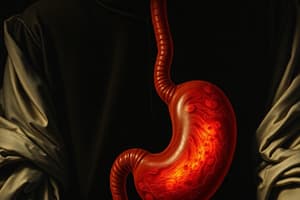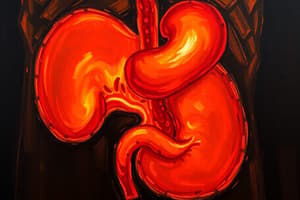Podcast
Questions and Answers
What is the cause of chronic gastritis?
What is the cause of chronic gastritis?
- Eating too much or rapidly
- Food contamination
- Benign ulcers of the stomach (correct)
- Autoimmune disease
What is the difference between Type A and Type B gastritis?
What is the difference between Type A and Type B gastritis?
- Type A is caused by H. pylori and Type B is caused by parietal cell changes
- Type A is associated with dietary factors and Type B is associated with autoimmune disease
- Type A is associated with low levels of hydrochloric acid and Type B is associated with high levels of hydrochloric acid
- Type A is caused by parietal cell changes and Type B is caused by H. pylori (correct)
What is the most common method used to detect H. pylori?
What is the most common method used to detect H. pylori?
- Endoscopy (correct)
- Upper gastrointestinal X-ray
- Histological examination
- Blood tests
Flashcards are hidden until you start studying
Study Notes
- Acute gastritis is an inflammation of the lining of the stomach.
- Causes include eating too much or rapidly, food that is highly contaminated with disease-causing microorganisms, alcohol and aspirin intake, and bile reflux.
- Symptoms may include nausea and vomiting, abdominal pain or cramps, blood in stool and vomit, diarrhea, fever and headache.
- Chronic gastritis is a prolonged inflammation of the stomach.
- It is caused by benign ulcers of the stomach, malignant ulcers of the stomach, or by Helicobacter pylori.
- Type A gastritis is caused by parietal cell changes leading to atrophy and cellular infiltration, and is associated with autoimmune disease such as pernicious anemia.
- Type B gastritis is caused by H. pylori.
- It affects the antrum and pyloric (lower end of the stomach near the duodenum), and is associated with dietary factors such as hot drinks, spices, food, use of drugs, alcohol, smoking and reflux of intestinal contents into the stomach.
- In Type A gastritis, there is absence or low levels of hydrochloric acid, and in Type B gastritis, there is hyperchloric acid (high level of hydrochloric acid).
- Endoscopes are used to detect H. pylori, upper gastrointestinal X-ray antibodies are used to detect H. pylori, and histological examination is used to detect H. pylori antigen.
Studying That Suits You
Use AI to generate personalized quizzes and flashcards to suit your learning preferences.




